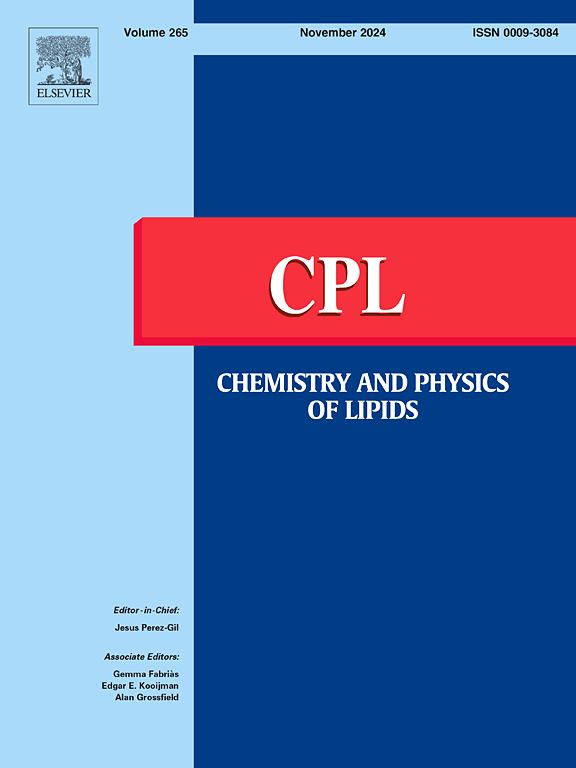Impact of α-tocopherol derivatives on the structural and functional properties of model lipid nanocarriers: A biophysical modeling study
IF 2.8
3区 生物学
Q2 BIOCHEMISTRY & MOLECULAR BIOLOGY
引用次数: 0
Abstract
While α-tocopherol is widely studied for its antioxidant role in membranes, its potential as a functional component of liposomal carriers remains underexplored, despite their range of interesting biological activities and growing use in nanocarrier systems. This study systematically evaluates how three tocopherol derivatives - α-tocopherol phosphate (TP), α-tocopherol succinate (TS), and α-tocopherol polyethylene glycol succinate (TPGS)—affect nanoliposomes, focusing on colloidal stability, encapsulation efficiency, and fundamental membrane properties such as fluidity, hydration, and thermotropic behavior. Results showed that all α-tocopherol derivatives significantly altered membrane properties, inducing structural changes in both the lipid chain and polar regions of the liposome bilayer. TS enhanced membrane rigidity and reduced permeability, while TP increased fluidity and promoted payload release. TPGS, with its bulky PEG chain, stabilized liposomes but induced phase heterogeneity. Additionally, all derivatives lowered the lipid main phase transition temperature and altered its thermotropic behavior. Despite these disruptions, the derivatives preserved nanoscale vesicle sizes (∼100 nm) and monodisperse distributions (PDI < 0.3) over extended storage. These experimental observations were further supported by molecular dynamics simulations, which confirmed differences in membrane affinity among the derivatives, with TS showing the strongest binding affinity. The simulations also revealed that the derivatives' positioning within the bilayer and their interactions—mainly hydrogen bonding and hydrophobic contacts—contribute to their distinct effects on membrane structure and dynamics. Collectively, these findings demonstrate that α-tocopherol derivatives distinctly modulate liposomal membrane architecture and behavior in a structure-dependent manner, offering promising tools for tuning nanocarrier performance in pharmaceutical applications.
α-生育酚衍生物对模型脂质纳米载体结构和功能特性的影响:生物物理建模研究。
虽然α-生育酚因其在膜中的抗氧化作用而被广泛研究,但其作为脂质体载体的功能成分的潜力仍未得到充分开发,尽管它们具有一系列有趣的生物活性,并且在纳米载体系统中的应用越来越广泛。本研究系统评估了三种生育酚衍生物α-生育酚磷酸(TP)、α-生育酚琥珀酸酯(TS)和α-生育酚聚乙二醇琥珀酸酯(TPGS)对纳米脂质体的影响,重点研究了胶体稳定性、包封效率和基本的膜性质,如流动性、水合性和热致性。结果表明,所有α-生育酚衍生物均能显著改变膜的性质,引起脂质体双分子层脂链和极性区域的结构变化。TS增强了膜的刚性,降低了渗透率,而TP增加了流动性,促进了有效载荷的释放。由于其庞大的PEG链,TPGS稳定了脂质体,但引起了相异质性。此外,所有衍生物均降低了脂质主相变温度,改变了其热致性。尽管存在这些破坏,衍生物在延长的存储时间内保持了纳米级囊泡大小(~100nm)和单分散分布(PDI < 0.3)。这些实验结果得到了分子动力学模拟的进一步支持,证实了不同衍生物的膜亲和性差异,其中TS表现出最强的结合亲和性。模拟还表明,衍生物在双层中的位置及其相互作用(主要是氢键和疏水接触)有助于它们对膜结构和动力学的不同影响。总的来说,这些发现表明α-生育酚衍生物以结构依赖的方式明显调节脂质体膜的结构和行为,为调整纳米载体在制药应用中的性能提供了有前途的工具。
本文章由计算机程序翻译,如有差异,请以英文原文为准。
求助全文
约1分钟内获得全文
求助全文
来源期刊

Chemistry and Physics of Lipids
生物-生化与分子生物学
CiteScore
7.60
自引率
2.90%
发文量
50
审稿时长
40 days
期刊介绍:
Chemistry and Physics of Lipids publishes research papers and review articles on chemical and physical aspects of lipids with primary emphasis on the relationship of these properties to biological functions and to biomedical applications.
Accordingly, the journal covers: advances in synthetic and analytical lipid methodology; mass-spectrometry of lipids; chemical and physical characterisation of isolated structures; thermodynamics, phase behaviour, topology and dynamics of lipid assemblies; physicochemical studies into lipid-lipid and lipid-protein interactions in lipoproteins and in natural and model membranes; movement of lipids within, across and between membranes; intracellular lipid transfer; structure-function relationships and the nature of lipid-derived second messengers; chemical, physical and functional alterations of lipids induced by free radicals; enzymatic and non-enzymatic mechanisms of lipid peroxidation in cells, tissues, biofluids; oxidative lipidomics; and the role of lipids in the regulation of membrane-dependent biological processes.
 求助内容:
求助内容: 应助结果提醒方式:
应助结果提醒方式:


